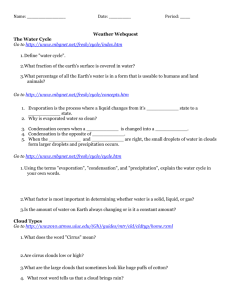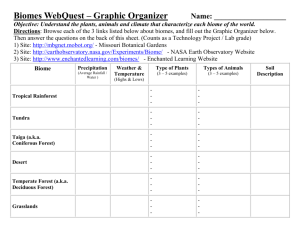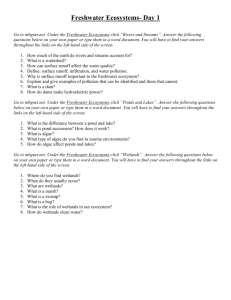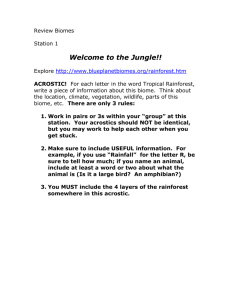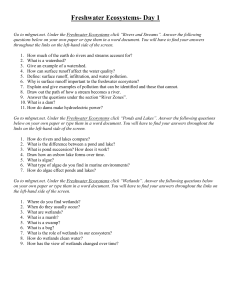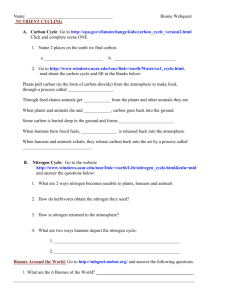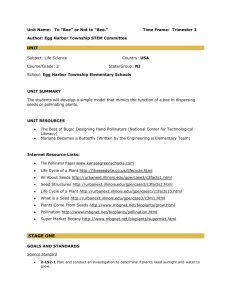File
advertisement
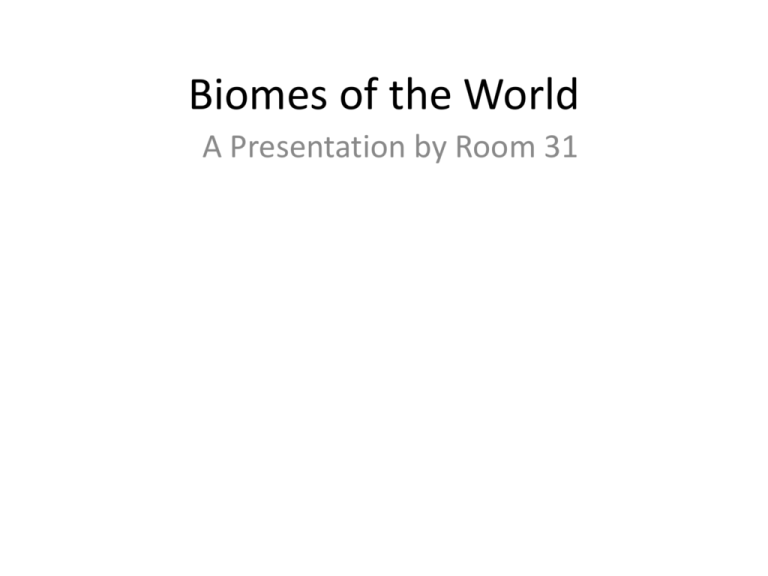
Biomes of the World A Presentation by Room 31 A lynx is not so common . It is almost identical to a regular house cat but larger . It has a powerful body attached on short, furry legs with hefty feet, and bobbed black-tipped tail. Its fur is spotted and yellowish http://www.mbgnet.net/sets/taiga/index.htm The moose is a very large and peaceful animal and so amazing the. Moose is not a vegetarian or a carnivore. In the morning it eats greens and plants at night time it prays on other smaller animals and eats them. http://www.mbgnet.net/sets/taiga/index.htm The wolverine is a carnivore . It can get up to 87 centimeters and as a adult can weigh about 45lbs. It has strong jaws that can bite through frozen meat and bone. It can kill animals bigger than its self. http://www.mbgnet.net/sets/taiga/index.htm Paper Birches are deciduous trees that live in the south end of the Taiga. They are tall and white like other birches. Paper Birches http://www.mbgnet.net/sets/taiga/index.htm In the taiga the warmest it should get 75 degrees. In the winter it can get – 68 degrees. It snows a lot and only rains when the snow melts. Climate http://www.mbgnet.net/sets/taiga/index.htm The taiga is located in most of Canada, some of Europe, Russia, and some of Asia. The taiga is the largest biome in the world Where is the taiga http://www.mbgnet.net/index.html thank you for the pictures and information Nolan Thank you brain pop and MBGnet . Net for your great pictures and amazing information. Collin Jack By Nikhil, Nick K, and Ben B http://www.mbgnet.net/sets/grasslnd/index.htm Earth is home to over 14 million sq. miles of Grasslands. ¼ of the earths surface is Grasslands http://www.mbgnet.net/sets/grasslnd/ind ex.htm Climate can drop to 32F and rise in mid summer to 86F. Grasslands can get up to 20 to 30 inches of rainfall in late spring. Almost every year a Grassland can get up to 130 inches of rain and all can come down in 1 to 2 weeks http://www.mbgnet.net/sets/grasslnd/index.h tm Easily identify the bright orange colors covering over its fruit. It resemble Chinese lanterns. It is native from southern Europe east across southern Asia to Japan. These are common in Grasslands http://en.wikipedia.org/wiki/Physalis_alkekengi GRASSLAND GRASS REGULAR GRASS The roots of Grassland grass can extend nine feet below ground. Grassland grass is highly flammable because it’s dry. Regular grass stay short unless not cut. http://en.wikipedia.org/wiki/Grass Black Footed Ferrets are mammals. The body is 45 cm the tail is 12.5 - 15 cm. They also eat other small mammals. The Black Footed Ferret is mostly found in prairies. http://www.mbgnet.net/sets/grasslnd/in dex.htm Saigas live on the steppe from Europe to Central Asia. Its nose is the most remarkable feature of the Sagia because it is long and drooping, with nostrils that point downwards. its horns are believed to have medical property's . http://go-passport.grolier.com/ Male Female Lions can be found in Africa, Northwest India, and Grasslands. There diets are large mammals, smaller mammals, and birds. http://en.wikipedia.org/wiki/Lion Books Endanger Grassland Animals By David J Taylor Grasslands By Lilly Erlic Biomes of the World Temperate Grasslands By Michael Allaby Websites http://en.wikipedia.org/wiki/Grass http://www.mbgnet.net/sets/grasslnd/index.htm http://go-passport.grolier.com/ http://en.wikipedia.org/wiki/Physalis_alkekengi http://en.wikipedia.org/wiki/Lion By: Alaina, Dalia, Milan Locations • • • • • • • • • • Latin America Brazil South East Asia West Africa Madagascar South America Australia Zaire Papua New Guinea Indonesia Rain forest or located close to the equator. http://www.mbgnet.net/sets/rforest/index.htm Animal of the Rainforest Many animals in the Tropical Rainforest camouflage. Vine snake Walking stick http://www.mbgnet.net/s ets/rforest/index.htm http://go.grolier.com/ Katydids http://go.grolier.com/ Rainforest Endangered Rainforest used to occupy 14% of earth’s surface, but now only 7% remains. Animals chimpanzee http://www.mbgnet.net/set s/rforest/index.htm Flying Dragon http://www.mbgnet.net/ sets/rforest/index.htm Bearded pig Common tree shrew Crested guan Parrot http://kids.nceas.ucsb.e du/biomes/rainforest.ht ml The Parrot is one of the many species of birds that live in the Tropical Rainforest. It has many beautiful colors on its wings Plants Bamboo http://www.mbgnet.n et/sets/rforest/index. htm Double Coconut http://en.wikipedia.org/wiki /Double_Coconut Ginger http://en.wikipedia.org/wiki/Ginger Banana and Plantain http://www.mbgnet.net /sets/rforest/index.htm Banyan Tree http://en.wikipedia.org/wiki /Banyan Consumers http://www.wikipedia.org/ 3rd Level Consumers 2nd Level Consumers 1st Level Consumers Climate • Warm • Wet • Humid/Damp This biome is considered as a “rain maker” because of the 600 cm. of rain each year. Rainforest help clean the world and slow down greenhouse effect. THANKS TO… Groiler, Biomes of the World, Wikipedia, Brainpop, World Biomes By: Taylor Blake, Michael Geier, Mei Pantuso, and Alec West Deserts are very dry they get about 10cm of rain a year. Deserts can be hot or cold depending on where they are. Deserts are usually hot during the day and cold at night. NOCTURNAL ANIMALS Rabbits Bats Owls Coyotes Mice Deer DIURNAL ANIMALS Lizards Toads Squirrels Snakes Most of the deserts are located near the equator. Deserts are located in, America, Mexico, Brazil, Asia, and Australia. The camels are the biggest mammal in the desert. Camels are nicknamed the ships of the desert . They store water in their hump . Camels can go up to two weeks without any water They can drink 22 liters in one day http://www.bing.com/search?q=camel+images&form=MOZSBR &pc=MOZI&adlt=strict A fennec fox is the smallest type of fox. Fennec foxes eat small mammals. Most of the fennec foxes live in North America. The fennec foxes ears are 15cm long. http://www.mbgnet.net/s ets/desert/index.htm Cacti have a thick waxy skin so as to cut water loss to bare minimum http://www.mbgnet/sets/desert /indexhtm Saguaro cactus Bibliography http://www.bing.com/search?q=camel +images&form=MOZSBR&pc=MOZI& adlt=strict The natural world book http://www.blueplanetbio mes.org/climate.htm http://www.mbgnet.net/s ets/desert/index.htm The Artic Tundra By Anna, Samantha, and Matt Location The Tundra is located at the top of the world, near the North Pole and the Artic Circle This enormous biome covers about a fifth of the earth’s surface Covers part of the part of the land of Russia, Canada and Norway http://www.mbgnet.net/sets/tundra/i ndex.htm Climate http://www.mbgnet.net/sets/tundra/index.htm The Tundra is the coldest and one of the driest biomes. Temperatures can dip to -60 degrees Fahrenheit in the winter. The average temperature can range from 50 degrees to 32 degrees in the warmest month. Annual precipitation is very low, it is usually less than 10 inches. The Tundra’s winter usually lasts from September to April or May. ~The Polar Bear~ http://www.mbgnet.net/sets/tundra/i ndex.htm The Polar Bear mostly eats large mammals. Sometimes The Polar Bear eats seals but its diet normally includes fish or small birds. They have a thick layer of fat to keep them warm. Polar bears depend on the icy artic to live. The Artic Fox The artic fox comes in two different winter colors which is white and “blue” which is actually a gray/blue. Their diet is rodents and birds. Their size of their bodies is 46-63cm. http://www.mbgnet.net/sets/tundra/i ndex.htm The Caribou http://www.mbgnet.net/sets/tundra/i ndex.htm Caribou are found above the tree line in artic North America and Greenland. They are part of the deer family. They live in huge herds. Caribou constantly migrate over long distances to avoid cold or look for food. Their thick fur coats keep them warm. Each of their hairs is hollow and traps warmth from their bodies to keep them from freezing. The Narwhal The narwhal has a spiral tusk that comes out of its mouth. The males have a sharp tooth that they use to fight with during breeding season. Plants http://www.mbgnet.net/sets/tundra/i ndex.htm Lichen Dark Red Leaves During the short-growing seasons in the summer, the tundra blooms with a variety of plants. The plants often grow small and grow close to the ground. One type of plant is a lichen. Lichens are unusual organisms that often grow on exposed rocks. They are composed of fungus and algae living and growing together. Another type of plant is dark red leaves. Many plants, such as this one, have leaves that are dark. Dark leaves allow the plant to absorb more heat in the cold tundra climate. Bibliography http://www.mbgnet.net/sets/tundra/index.htm Tundras By Erinn Bantins Tundra (Life In a Frozen Landscape) By Greg Roza Artic Tundra By Janey Levy Temperate Forests http://www.mbgnet.net/sets/temp/index.htm animals Rat snake Blue jay Gray squirrel Bank vole Cardinal Owl http://www.mbgnet.net/sets/temp/index. Black bear htmhttp://www.mbgnet.net/sets/temp/in dex.htmhttp://www.mbgnet.net/sets/tem Mice p/index.htm And many more… location The temperate forest is located in the northern and southern part of America. It is also in the northern part of Asia and Europe and it is in a small part of Australia. Location http://nbps.grolier.com/media/085/a000226.gif plants Deciduous plants Broadleaf trees Hardwood trees Oak trees Maple trees Hickory trees Ash trees Beech trees Redwood trees Shrubs Wildflowers climate The temperate forest has four seasons summer, winter, spring, and fall. The average amount of precipitation is 39.4 in. the average amount of rain fall is 30 to 40 in, the average amount of snow fall is 12.3 in. the average high is 63 ̊f, the average low is 44.2 ̊f, and the average temperature is 53.6 ̊f. Zack, Carly, and Zion We thank all the books we read and the wonderful websites we used: http://www.infohio.org/, http://moodle.centerville.k12.oh.us/ , http://go-passport.grolier.com/ By Megan, Audrey and David http://www.maps101.com/index.php?option=com_fl exicontent&view=items&id=183%3Aoceans-role-inglobal-warming&cid=2%3Ageography-in-the-news • Medusoids are free swimmers like jellyfish. • The tentacles point downward. http://www.mbgnet.net/index.htm • If an octopus loses an arm, it can grow a new one. • An octopus has three hearts. • An octopus can turn different http://nbk.grolier.com /encycmedia/gepq0001 colors or 88/0mp transparent. Coral is also related to sea anemones, hydroids and jellyfish. http://www.mbgnet.net/salt/coral/index.htm Did you know…? Green Algae was developed two billion years ago! http://go.grolier.com The average temperature of oceans is 39F(4C) The temperature for Polar Regions is 28F(-2C) The temperature for the Tropical Regions is 97F(36C) Missouri Botanical Gardens Science Textbook Oceans By Heather C. Hudak Life in an Ocean By Carol K. Lindeen Grolier Maps 101 If a starfish loses an arm, it can grow it back. Between the 1950’s and the 1990’s, six million dolphins died in fishing nets. The deepest part of the ocean is seven miles deep. Mount Everest is only six miles high. Sharks skeletons are made of cartilage. The Pacific Ocean is the biggest ocean. Thanks for watching. Watch again sometime! http://www.mbgnet.net/sal t/coral/index.htm http://www.mbgnet.net/ salt/oceans/index.htm By Jodie Young, Lauren Lemmerbrock, Bobby Franklin Rough Skinned Newt Eats insects and lives in ponds, lakes or streams They are also considered part of the lizard family. http://www.mbgnet.net/fresh/lakes/index.htm Largemouth Bass These fish eat fish, frogs, and more. You will find these in lakes, rivers, and ponds. They are normally found in the Gulf of Mexico. http://www.mbgnet.net/fresh/lakes/index.htm Zambesi Softshell This turtle eats snails and is most often found in ponds, lakes, and rivers. http://www.mbgnet.net/fresh/lakes/index.ht m Algae - This is blue green algae - It is very slimy - Algae is just bacteria - It lacks nuclei and its pigment is scattered. http://www.mbgnet.net/fresh/lakes/index.htm Microscopic Algae - Dinoflagellates float freely in water - They are microscopic which means they are so tiny that you can only see them with special tools http://www.mbgnet.net/fresh/lakes/index.htm Locations The largest rivers and streams are River Country Miles Nile Egypt 4,145 6,670 Amazon Brazil 4,000 6,404 Chang jiang - Yangtze 6,378 Mississippi-Missouri (river system) U.S. 6,021 Yenisei-Angara (river system) Russia 5,540 Disclaimer Kilometers China 3,740 3,442 3,964 In the fresh water biome, in the bottom layer it is about 39-45 degrees F. However the bottom layer is where most plants and animals live. The middle layer being 45-65 degrees F is the layer in which the temperature drops frequently. Yet the top layer being the warmest, is 65-75 degrees F. The creatures stay at the bottom because all of the plants are down there. Fish also do not like surface so they stay as low as possible or needed. Some times humans are at the surface swimming or boats are floating. There are many fresh water biomes in North America, Africa, and even Asia. In fact, there are 2 great lakes in North America. One is the Superior, it is 406 meters deep. There is also Lake Huron, which is nearly 229 meters deep. But we don’t know how many living things are around there Credits Pictures are from: http://www.mbgnet.net/fresh/lakes/index.htm Information from: Natural Life http://www.mbgnet.net/fresh/lakes/index.htm Slide show producers: Lauren Lemmerbrock Bobby Franklin Jodie Young Thank You For Watching!
